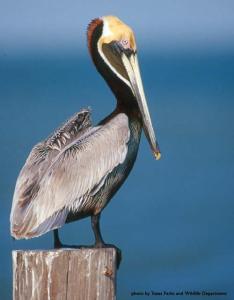Mason Nistad
Brown Pelican
Pelecanus occidentalis
The brown pelican is a dark brown bird with a darker brown-ish black stomach, the brown pelican has a yellow head and a brown beak and brown legs. The brown pelican can be found in warm waters or marine estuaries, and more specifically the Atlantic and Gulf coast. All animals belong to domain, kingdom, phylum, class, order, family, genus and species. Its domain is Eukarya, its kingdom is Animalia, its phylum is Chordata, its class is Aves, its order is Pelecaniformes, its family is Pelecanidae, its genus is Pelecanus and its genus is occidentalis. The brown pelican has bilateral symmetry, that means if you were to draw a line down the center of the pelican each side would match up perfectly. One adaptation of the brown pelican is its dark brown color, which helps them camouflage with the mud and grass they can also blend in with the dark muddy waters (depending where you live).That is a structural adaptation. Another adaptation of the brown pelican is its big beak. Pelicans have a big, hollow area in their beak called the gular pouch. The gular pouch provides storage for up to 3 gallons of water (2-5kg). That is a structural adaptation. The last adaptation of the brown pelican is how it stays very close to its nest. That keeps all babies very safe because the parents are always close by. Its also makes it easier for parents to get food for the new born birds because they always make the nest close to a place with many of its prey. That is a behavioral adaptation. One interesting fact about the brown pelican is that they can hold more water in their gular pouch than in their stomach. The brown pelicans prey consist of shell fish and anchovies and their predators are mostly humans and bobcats. Bobcats usually eat their chicks and humans hunt them for their meat, eggs and even feathers. The brown pelican is a heterotrophic organism, which means it gets energy from other organisms. Lastly the brown pelican is an ectothermic organism , which means that they are a cold blooded animal. |
| www.tpwd.texas.gov |
No comments:
Post a Comment